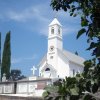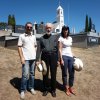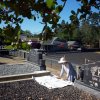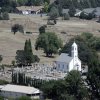This is a part of an answer written by the Holy Bishop Nikolai to a greiving mother who had lost her husband and children and does not know where they are burried. This entire answer is published in the American Srbobran. This advice of bishop Nikolai serves well as an introduction to this story about the cemetery in Jackson, California. Why? Jackson residents had a rare opportunity this summer to meet and host two religious education school teachers, from Serbia who spontaneously decided to dedicate their private visit to cousins in America, and their free time to the old cemetery in Jackson.Through the intensive and dedicated two-week work and their own action, they fullfilled and reminded all of us about these words of the Holy Bishop of blessed memory.
As a reminder, the Serbian immigration to America is connected with the town of Jackson California, Amador county California, and Archimandrite Sebastian Dabovich who was born in San Francisco. Many immigrants came to Jackson where they worked in the underground hard rock mines searching for the precious metal, gold; among them were great numbers of Serbs. This is how the first Serbian Orthodox Church, dedicated to Saint Sava the first Archbishop of the Serbian Orthodox Church, was built back in 1894. On the consecrated ground surrounding this first Serbian Orthodox Church, the cemetery was established for the burial of Serbian immigrants.
Religious teachers, Stanislav Budisavljevic and Dragana Masic, with the blessing of His Grace Bishop Maxim of the Western American Diocese, and with great joy of Jackson's Serbs, made an effort to bring one noble thought into a concrete act. Their idea was to photograph and catalog all tombstones and to create a unique new photo archive with a registrar of each individual buried in the cemetery.According to the parish records from 2013 which they obtained from the cemetery office, in the Jackson cemetery there are 344 graves. Some of them are family graves, meaning that more than one person has been buried there.
The main guiding post for Stanislav and Dragana was the plot map of the cemetery produced in 1983. This map over the years has seen many changes and new additions. However, because of irregular updating, it proved to be deficient considering the methodical and diligent research being undertaken by Stanislav and Dragana.The second guiding post was the two metrical books of baptisms and burials. These two books proved to be great aids in clearing up some doubts and ambiguities of the records. Stanislav and Dragana's determination in finding answers to some questions led them to discover a very old book recorded by Archimandrite Sebastian Dabovic in 1896. Jovan Dabovic, Sebastian in monasticism, was the first Serbian apostle and missionary on the American continent. The Western American diocese celebrates two hundred years of his birth this year. On January 11, 1894, Father Sebastian received a blessing to build the first Serbian Orthodox Church on the American continent in Jackson, where as mentioned earlier, there lived a large group of Serbs. The building of the church was completed on December 4th, 1894, whenit was consecrated by Biship Nikolai of Alaska, and Aleuts who for this occasion gifted the church with the bell. Archimandrite Sebastian died at the monastery Zicha in 1940. His funeral was served by Saint Nikolai of Zicha (Velimirovic). With the decision of His Grace Bishop Chrisostom of Zicha, and with initiatives of the Jackson clergy and parishioners and the efforts of our Bishop Maxim, Father Sebastian’s earthly remains were transferred from the monastery Zicha into Saint Sava Church in Jackson during the summer of 2007.
A big help with researching the archieval details about the people buried in the cemetery was provided by the Amador County Administration Center. This was especially important since the church burial records hadsome information gaps that needed to be filled.
More help was alsoreceived from Daneri Mortuary in Jackson in obtaining missing information for three unmarked graves with only last names marked on the cemetery map. The mortuary aided with the records research by showing us their records of death certificates going back to the days of the gold rush eraresulting in the discovery of missing data.We all felt this warm connection to these names of those brothers and sisters when such missing data was found, thus reminding us of the words of Saint Nikolai's story. Upon seeing the death certificate of one young Serbian miner George Sredanovic confirming his missing date of death, there also was revealed the word 'none' entered for 'next of kin', arousing in us the deeper, contemplative spiritual aspect, and purpose of this work.
At the cemetery, all graves have been photographed and recorded, all epitaphs written in the Cyrilic alphabet have been read and interpreted. Among them there are many beautiful tombstones. Some are damaged, some of them are missing a cross. There is a plan, with the blessing of His Grace Bishop Maxim, to repair all the damaged tombstones and facilitate preservation of the really old ones.The oldest grave, if we look at the year of death as recorded on the tombstone, is the grave of three year old Marko, son of Simo and Nina Dragomanovic, who died in 1887. The Dragomanovic's were founding members of Saint Sava Church in Jackson.
In this cemetery there are several graves of Orthodox Americans of recent times who were a part of the Saint Sava Liturgical community of Jackson.
As observed by Stanislav and Dragana, tombstones indicate that the greatest number of people came from Herzegovina, Crna Gora and Boka, and from this observation came their idea that there should also be a geographical registry, in addition to an index with last names and first names of the buried that will be recorded. The website, eserbia.org/graveyards has the results of Stanislav’s and Dragana’s work, who wish to be referred to as Orthodox Christian education teachers.
With this story about the Jackson cemetery and the exceptional work of our dear guests from Serbia who have inspired us and awakened within us the sensibility and awareness of the meaning of the preservation of every grave, we will finish by quoting the entire answer of Bishop Nikolai to the grieving mother that we started at the beginning of this article.
Lo, hear me now, as I tell you this story, which can serve to you as an example. One Soul Saturday, I was walking through the enormous and magnificent Belgrade cemetery. All around me, as far as you can see, thousands and thousands of candles were shining as the most beautiful flowers that people can plant into earth. In those flames I was reading joy of departed who as if quietly were singing: we’re alive, we’re alive! At the end of the cemetery I saw one lady known to me. She was standing above some forgotten graves and illegible tombstones and burial mounds without any markings. Above those graves she lit several dozens of candles. She watched those candles with a contrite heart and in their flickering read the joy of those under the ground. She cried. I asked her who from her family is buried there. No one, she answered. My husband, she said, was moved recently to Belgrade, and all of our departed loved ones were buried in the place of his former duty assignment. I, she said, cannot go there since it is too far, so I came to these neglected and forgotten graves, to do for others what I cannot do for my departed family members. My hope is that the Loving God will receive this for my family as well.
-He will, madam, He will for sure, I said thinking to myself as I walked away: Lord, how smart these people are! How much a man can learn from people taught by God!
Dragan Stojanovich
Jackson, California









